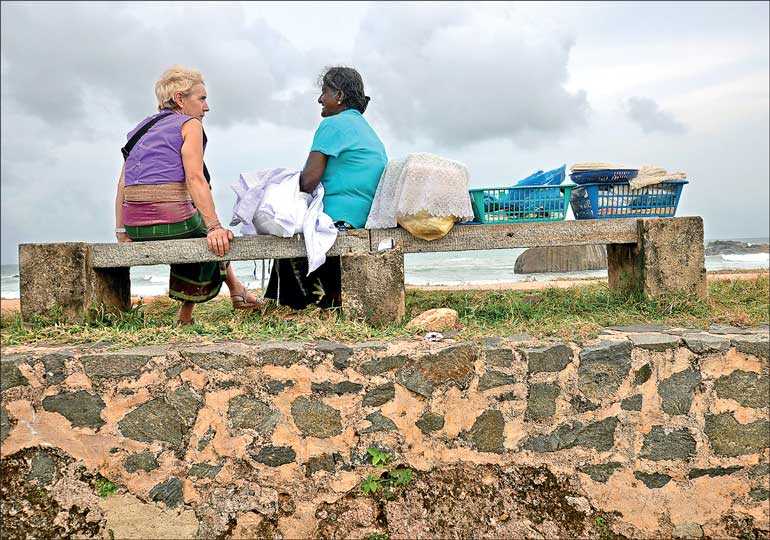Wednesday Apr 24, 2024
Wednesday Apr 24, 2024
Wednesday, 1 January 2020 00:15 - - {{hitsCtrl.values.hits}}

Throughout human history there have been those who went exploring geographies away from their native land. In the early days some went on these type of explorations looking for resources, be it food or other needs or later for more economically valuable resources. They went in search of things of value. They not only brought those valuable things but experiences and stories. 
Even most religions crossed borders in that way. Then there were pilgrimages of those who went to holy places. In Sri Lanka most of our early travels were linked to such pilgrimages. With the advent of safer more convenient ways to travel, travelling to see other countries to gain new experiences has evolved in to one of the largest industries in the world. Naturally we in Sri Lanka too see tourism as a high potential industry. Thus every tourist to us is a potential economic unit.
But do you want to be perceived as an economic unit? Or you want to be considered a human being? The private bus conductor who refers to a passenger as “visse kellak” – ‘a twenty rupee piece’ – is considered as having a bad attitude. Then how come considering a tourist as a dollar unit or a ‘dollar kellak’ is any different?
‘Aganthuka sathkaraya’ in ‘paradise’
Tourists spend their own money and come all the way to see and experience a destination. They are guests in our midst. Instead of considering them as economic units but as visitors our attitude will change. Guest is given so much importance in our culture. That is why we have the term ‘aganthuka sathkaraya’.
This word sathkaraya cannot be easily translated to English. It is not just care or service. It is about considering the other persons need more than my need. Traditionally we do not ask the guest what she want because we always give the best we have to the guest. It is this insight that drove me to coin the word ‘paribhogika sathkaraya’ for customer care when I published the first ever book on customer care in Sinhala, under the ‘Sinhalen Business’ book series.
In tourism marketing the easier part is promoting a destination. So much is written about that but I want to discuss the difficult part, which is delivering the promise. The Tourism Board can run the most effective communication campaign across the globe and perhaps that will influence millions to visit us one day.
Though we have been changing the positioning strategy every time a minister changes, we continue to present Sri Lanka as a paradise. That is the bottom line. So our guests come to this island want to discover and experience paradise. Now the question is who delivers this promise.
Parallel or even prior to the international campaign we must make sure that at every touch point the guest discovers the same experience we have promised. This is not easy since there are many who will deliver this experience.
In 1997 I worked for UNDP Quality Tourism Project in Nepal under Renton de Alwis. During this period I visited Machan wildlife resort within the Chitwan National Park. They had just started the property at that time. The tag line was ‘discover the Chitwan Park in the lap of luxury’ or something closer to that meeting. And the biggest customer complaint they had was lack of electricity. This was to be expected, since electricity is such a basic facility and when you say luxury how can one not expect it to be there. My advice was for them to drop that line.
At the other end of the Chitwan Park was Tiger Tops, a high end property. From the time you contact them they condition you to expect very rustic and basic facilities but when you go you really experience more than that and the result is a natural ‘wow’.
Now compare this example with a potential visitor to Sri Lanka. We need to follow the journey from the time one applies for visas till she returns. First contact point is the airline crew if she chooses SriLankan otherwise the first contact point is the Immigration counter.
It is a very sensitive point on one hand the officer has the responsibility to screen the person who is in front of him or her to ensure that the visitor is genuine and desirable to given permission at the same time all genuine visitors expect a warm welcome because of our communications that promised a smiling nation.
Then the customs, the cab service, etc.
Those who are directly involved with tourism hopefully are trained. Except some well-known properties and service providers I am not sure whether others invest in training and developing those who work on customer care.
Consider all other interactions that a visitor to Sri Lanka goes through and evaluate how that will support deliver our brand promise. It is far more complex than training the staff in travel and tourism sector. It should be a nationwide change in attitude. That is why I propose that we should position tourist as our guest within the country. In Nepal they say ‘Atiti devo bhavan’ – ‘Guest is God’. Our traditional concept is no different. There must be a national program to ensure we are ready truly to welcome our guests wherever they go.
Policy level round table
Tourism is a devolved subject and each provincial council also has a Tourism Ministry and a division. Then there are other ministries other than tourism that can have an impact on tourism such as Foreign Affairs, Police, Transport, Health, Education, Environment, Culture, Investment Promotion, coast conservation, Forest Wildlife, Infrastructure Development, etc.
Therefore there must be a permanent national level round table or a policy planning forum where the tourism perspective and related inter-dependencies are regularly reviewed and holistic decisions are made not only at the Central Government level but with the Provincial Council level as well.
Ensure quality experience across
Publish minimum hygiene standards that must be adopted by all those who provide such services such as restaurants, home stays, and spas.
Let the Local Government agencies to implement those standards strictly and display the ratings whether the place is frequented by tourists or not.
Toilets
One of the most embarrassing moments is visiting toilets in public places. We are a nation who used water sealed toilets in third century BC in Anuradhapura period. Those monasteries had thousands of monks and with so clear vinaya rules about the use of toilets they were using very advanced toilet systems. They had not only carved stone urinals and squatting pans, but also very advanced filter system. Somehow we have lost the tradition of maintaining very clean toilets.
In 1984 or so when I was in advertising a research revealed that only 35% of the users of toilets used anything other than water to clean toilets. Today with a number of toilet cleaners being available, the situation is far improved. But what is the condition with most public toilets?
It might be a good idea to leading bath ware manufacturers to set best in class toilets in all major tourist attractions and with the help of the Archaeological Department and engineers to develop the same filtering system.
There must be facilities for Muslim travellers to wash their feet since it is an important requirement before prayers.
Good tea
It is encouraging that the branded tea consumption is increasing but how often can we get a good cup of tea when you really want it?
Shouldn’t a leading tea brand train persons in roadside restaurants and guarantee the visitors that they can have good quality tea in such places linked to the brand?
Capacity
This is a major issue in our major attractions. We need to think of more creative ways to ensure that we do not allow places to be over crowded such as Sigiriya.
Pricing and timing can be used like in similar international attractions.
Basic customer care
Unless all shop keepers are good in customer care we cannot assure a good experience only for tourists. The overall customer care must be improved across the nation. This was a strategy used by Singapore.
In time to come more and more tourists will travel as Free and Independent Travellers (FITs) because of the availability of knowledge via internet and peer recommendations. This means that they will frequent not only the touristic shops but other retail outlets as well.
Secondly, the retail shopping is going to be a valuable part of the tourism-related industry. Unless there is a very broad appreciation of customers this cannot be delivered. Benchmark this with the Japanese retail system.
All three-wheel drivers and cab drivers and app-based cab service providers all must be conversant of at least the basic mannerism and customer service standards.
Product development
Encourage and provide knowhow so that those who offer services to guests can make them more experiential by developing novel products. Lack of exposure is the main reason for that.
There are so many opportunities to create magic with what we have to offer as a country. Today’s international travellers look for such unique experiences. These are ways to increase the number of days they spend in a country.
General attitude
Media and communication can play a significant role in shaping public attitude to ensure that we treat these tourists as guests who have come to visit us. No visitor to Sri Lanka should go back with memories of harassment or being cheated.
I remember watching a video on Nepal TV where a cab driver finds a forgotten wallet of a tourist. He goes back to the hotel and returns the purse. The tourist gives the driver some money. He refuses to accept any gifts but invites him home. The tourist goes to his humble abode with him where he is treated to traditional hospitality. And the story ends with the message ‘Atiti Devo Bhavan’ – the guest is god.
We too have such incidents but we need to make them more popular and make such behaviour highlighted as role models. Such true stories converted into mini short videos must be shown over televisions and some of these must be woven into the popular teledramas.
Bring in customer care as a topic in school, so the concepts get widely accepted.
Perhaps either the Tourism Promotion Authority or national institutes such as Institute of Marketing can develop a series of educational videos and publish them on social media. These videos can educate in all three languages how to greet and serve customers in different industries and popularise good experience stories so they will influence behaviour of others.
Now foreign and even local travellers look for good places based on star ratings given on websites such as Trip Advisor and Booking.com. These sites also carry valuable customer feedback and they are very authentic most of the time. If these are collated and analysed overall, the industry can learn so much.
Perhaps there can be a national level platform where visitors to the country can leave feedback on different experiences and such feedback can be used to improve the services.
Another important aspect is positioning the travel and tourism trade as a desirable occupation sector. Unless we attract sufficient numbers to join this industry, we might have to import labour.
Conclusion
This is not a comprehensive paper on the topic but an attempt to illustrate how difficult to ensure the tourists we bring to the country experience what is promised since the delivery is done by more than those who are in the hospitality trade, therefore the need for a holistic approach.
(The writer is a management consultant, author, executive coach and can be reached via [email protected].)